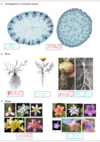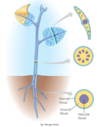S/A Lecture Notes Flashcards
(58 cards)
1
Q

A

2
Q

A

3
Q
EUKARYA SAR Clade: ALVEOLATES. LOCATE SACS

A

4
Q
EUKARYA: SG2=SARCLADE (Alveolates: dinoflagellate,plasmodium, CILIATES)

A

5
Q
EUKARYA:SG2 SAR CLADE= Aveolates(d+plasmodio+C) &STRAMENOPILES

A

6
Q
EUKARYA: SG2 SARCLADE= Aveolates(d+plasmodium+C) & Stramenopiles( BA +Diatoms)

A

7
Q

A

8
Q
SG3:ARACHEPLASTIDA, RED, Green Algae

A

9
Q

A

10
Q
major group 4 in EUKARYA
A

11
Q
WHAT IS A PLANT?

A

12
Q

A

13
Q

A

14
Q

A

15
Q

A

16
Q

A

17
Q

A

18
Q

A

19
Q

A

20
Q
Lif in water is pretty sweet why?
why is water important, why do plants need water?

A

21
Q

A

22
Q
Novel traits developed by plants: DESSICATION(c+s+s) & STRUCTURAL SUPPORT AND TRANSPORTING WATER
A

23
Q
3 types non vascular plants byrophytes:
A
- thought to be closest living descendants ofn 1st land plants
- no vascular tissue
- no well developed roots

24
Q
NV: Byrophytes: liverwort

A

25
NV:Byrophytes= HORNWORTS key points


26
MOSSES (NVB)
ALSO, mosses: sphagnum are known to have high tolerence of dessication. due to microphyll cells (PS and H)

27
1. LYCOPHYTES in seedless vascular plants


28
1. MONOLYPHYTES in SEEDLESS VASCULAR PLANTS

29
1. MONOLYPHYTES: reproduction in SEEDLESS VASCULAR PLANTS

30
LINK SEED AND SEEDLESS PLANTS


31
FEATURES SHARED BY ALL SEED PLANTS: 1. all have seeds


32
FT SHARED BY ALL SED PLANTS : alternation of generation

GAMETOPHYTE REDUCTION, sporophyte INCREASE.
1. G= contain gametes,they are precious
2, in seed plants GAMETOPHYTE= protected against UV and dessication and OBTAIN NUTRIENTS FROM PHOTOSYNTHETIC SPOROPHYTES

33
FT SHARED BY ALL SEED PLANTS. 3. HETEROSPORY

V

34
GYMNOSPERM- SEED PLANTS, NO FLOWER REPRODUCTION


35
4 main types of gymnosperm

36
3 key innovations in angio sperms

37
1. AS: FLOWERS= EFFICEINT TRANSPORT OF POLLEN


38
1. PRODUCTION OF SPERM AND EGG IN ANGIOSPERM


39
2. AFTER POLLINATION (AS)


40
characteristics of monocot and eudicot , MAJOR GROUPS OF ANGIOSPERM

41


42
MONO OR EUDICOT?


43
3 TYPES OF TISSUE

44
1st TISSUE TYPE: dermal= epidermis


45
2nd type tissue GROUND!


46
LABEL GROUND TISSUE TYPE!!


47


48


49
PS&G: INDETERMINATE GROWTH how is it achieved?


50


51
Lateral Meristem


52


53
casparian strip


54


55
SHOOTS OF PLANT: monocot stem


56


57
58
4 EUKARYA GROUPS



